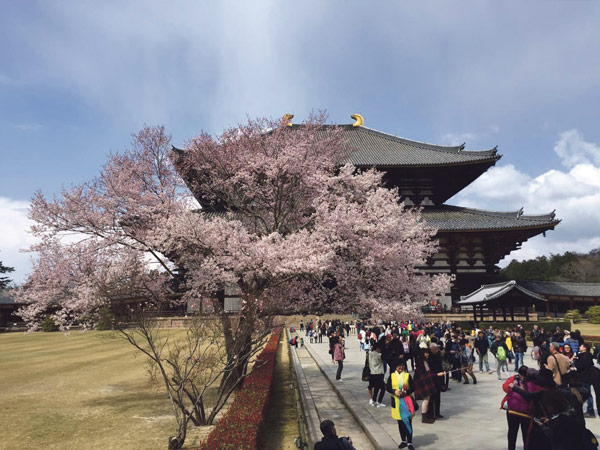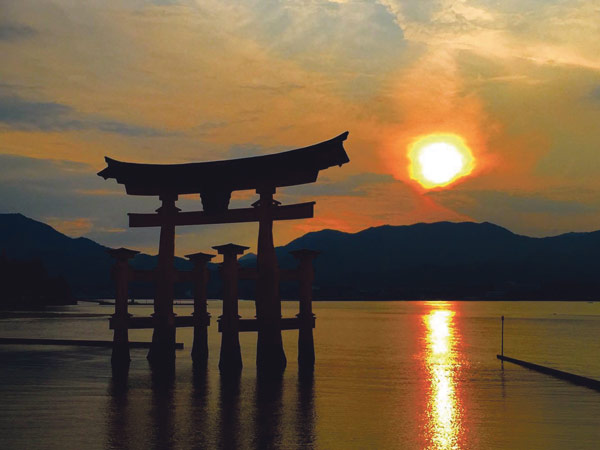Words are an insufficient tool for transporting someone to Japan. Do you want to hear about the food? The freshest fish in the world is served at the Tsukiji fish market before the sun rises. In Hiroshima, you can sit around a small heated table and fry your own okonomiyake, a savoury pancake filled with a variety of fillings, whose name derives from the Japanese for “how you like” and “grill”. Sweet red bean paste originated in the volcanic mountains of Hakone and the gooey rice cakes, mochi, are a speciality of Kyoto. The railway stations connecting Japan’s major cities hide labyrinths of underground bars and ramen stalls. And vegetables that don’t exist in the western hemisphere are grown alongside the rice paddies. Have you met the people? The tattooed Yakusa (Japanese mafia) hiding in a Roppongi club, the harajuku girls dictating global trends, the dignified lady in a kimono providing a direct line to the nation’s enchanting past, the school child whose backpack is bigger than him. What about the festivals? August is firework season so the sky explodes and fractures with scintillant displays of fire and smoke watched by couples clad in yukatta (a traditional summer kimono). In April, fertility is celebrated with an enormous penis being paraded through the streets, and wishes are granted through the Tanabatta festival where Japan’s trees are ladened with colourful strips of paper, each concealing a prayer, a secret or a dream.
A friend of mine has particularly exotic origins: half Japanese, half Jamaican, and when I asked how her parents met she told me that their paths crossed on a beach in the south of Japan. And while Japan is not immediately associated with beaches, its sandy shores are one of the country’s more spectacular features. Being an island, the country is inundated with beaches, but the three locations which most impressed me were Naoshima, Miyajima and Okinawa.
Naoshima is a remote island on the Seto Inland Sea. This floating paradise supplies you with a cocktail of Japan’s most eccentric qualities: enigmatic billionaires, untouched beaches, pioneering architecture, eccentric locals and celebrated artists. If, as you stroll its softly worn shores, you find yourself reminded of a James Bond movie set, you’d be close, as the novel The Man with the Red Tattoo was set in this intoxicating location. Approaching this remote land by boat, you are greeted by Yasoi Kusama’s bizarre pumpkins planted on the piers. These larger-than-life specimens have taken on the island’s ethos and transcend their viewers into a realm of the imaginary. Fukutake has transformed the space into a surrealist art archipelago as three islands now house an unimaginable collection of art, from a series of Monet’s waterlilies to cutting edge architecture by Tadao Ando.
This floating paradise supplies you with a cocktail of Japan’s most eccentric qualities: enigmatic billionaires, untouched beaches, pioneering architecture, eccentric locals and celebrated artists
Naoshima, meaning “honest island”, earned its name a thousand years ago when the Japanese Emperor was struck by the nature of its fishermen who to this day can still be found collecting seaweed on its shores. These island men are complemented by the nude diving women whose presence evokes memories of the ethereal mermaids of JM Barrie’s Neverland. Amongst the untouched scenery are the galleries, hidden beneath the surface of the earth, but ingeniously lit by natural sources. The Chichu Gallery, part of this complex, is home to one of the most mind-altering installation pieces you’re likely to find in the country. Delightfully contra to the bleached scenery it resides in, both rugged and delicate, James Turrell’s reflections on light and space is an almost viscerally pigmented series that spans his career. The experience must be had first-hand, but I will attempt a clumsy rendition here. You climb a dozen stairs leading to a large blue painting on the wall. As you take the final step, your face nearly touching the piece, you realise it is in fact an opening to a huge room soaked in blue light. Stepping through into this room, whilst clichéd, you do have a transcendental sensation, evocative of Alice freefalling down the rabbit hole, and every bit as psychedelic and mind-altering. Turning back, the orange of the gallery space fills the opening you walked through and so you feel as if you’re standing in an infinitely sized blue room with an orange painting floating on one wall, fully removed from the world you left.

Further South, off the coast of Hiroshima, is Miyajima Island, iconic for its floating torii gates. This island, revered by the locals as home to the Gods, was once deemed too holy for any man-made constructions. Therefore, the islanders chose to build the red torii gates in the ocean as a floating offering. Today there is a buzzing market winding around canals and selling wooden sandals, handmade sake sets, maple cakes and oysters. Sacred deer enjoy the market as much as the tourists, pillaging handbags for treats and soaking up the attention they rightly deserve. It helps that they’re preternaturally photogenic, of course.
Collecting seashells in the turquoise shallows of Okinawa, Naoshima or Miyajima, it is hard to remember you’re on the same planet as everyone else, let alone the Japan known for twenty-four hour salary men, hedgehog cafes and anime culture
Okinawa is the southernmost point of Japan, closer to Taiwan than the rest of the country and, occupied as it was by America after the war, is steeped in an interesting if contradictory history. A bundle of tiny islands are dotted around Okinawa, reachable by makeshift ferries. Among them, Zamami Island is the ultimate untouched paradise harbouring all the classics: white sand beaches, small fishing huts and – bizarrely – fields of growing pineapple. Routine on this island is fairly blissful, as mornings are spent on a stretch of beach known for its sea turtles and, at the right time of year, you can even watch the babies hatch. Following your morning turtle fix, you can cross the pineapple fields to reach the island’s other beach and spend your afternoon absorbed in kaleidoscopic coral reefs. The fishy underworld of coral and sea life is only a couple of meters from the shoreline and offers an almost globally unique opportunity to appreciate it without a scuba licence. Sunset is spectacular as, unlike the gentle lavenders of evening in Ireland, the Pacific sun races under the horizon line in a fiery blaze that turns the entire beach orange. There is only one place to stay and so Zamami fosters a tight community and you’re likely to know the names of all residents in the first few hours. The island is protected by whales who inhabit the surrounding waters and deer are seen at night swimming between the islands and resting on the beaches.
Collecting seashells in the turquoise shallows of Okinawa, Naoshima or Miyajima, it is hard to remember you’re on the same planet as everyone else, let alone the Japan known for twenty-four hour salary men, hedgehog cafes and anime culture. It’s difficult to imagine a more bittersweet sight than the fisherman who leaves this sanctuary to sell his fish at Tokyo’s Tsujiki fish market.







